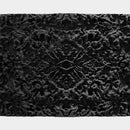Introduction: Etching Aluminum With a Waterjet
The OMAX Waterjet at Pier 9 is capable of cutting through several inches of just about any material you can imagine at a high level of precision. But it's also capable of generating remarkable effects by etching various materials as opposed to cutting through them. In particular, metals and stones produce very different, but equally interesting results when subjected to this process. After some initial trials, I became interested in the way that the combination of material and machine transformed my intended designs and suggested a kind of adaptive working method, one that required material engagement and sensitivity to more than just the digital inputs. These material studies became the basis for one of the major projects that I completed during my residency at the Pier.
In this Instructable, I'll share the basic digital workflow for setting up files to etch, discuss some of the material considerations you should keep in mind, and review some machine setup suggestions to prevent damaging either the machine or your material, and avoid making a too large a mess.
Step 1: Software: OMAX Intelli-Etch
If you've ever used a laser-cutter before, you're likely familiar with the process of etching. You provide the software with a raster image (.jpg, .bmp, .tif or similar) and by controlling the intensity of the laser at each sampled point, the image is created. The waterjet works similarly, but with a very important difference. Instead of varying the intensity of the water stream, the software will vary the speed at which the jet moves across the material - moving faster over lighter areas in the image while slowing down and dwelling longer in darker areas.
To get started, you'll need an image file. While you can use any kind of image you like, only the grayscale values of the image will be used to generate the etching. For this reason, I convert my images to grayscale to help clarify for myself what the results might be.
On the OMAX control computer, run Intelli-Etch*. Intelli-Etch functions as a wizard. Click 'Next' on the welcome screen. On the next screen, click the folder icon and browse to your image file. After it's loaded, click 'Next' and you'll have an opportunity to make edits to contrast, invert black/white, rotate, etc. I prefer to make all these changes in other image editing software, and bring a finalized image to Intelli-Etch.
Next, you'll be prompted to define a color border, similar to a mask. Note that this feature is very limited - a mask of any complexity will likely yield unpredictable results, which you will see once you import the file into Make.
After you've loaded the intended image, define a size for your etching. The larger your etching, the more memory it will take to generate the toolpath. Note that there is a low memory limit for Intelli-Etch as it's 32-bit software. Etchings larger than approx. 24" x 24" are challenging. One other option that will affect memory consumption is the step size. Note that Intelli-Etch handles this as a percentage overlap, unlike typical CNC convention of stepover. For those with lots of CNC experience, this will require a bit of acclimation.
Lastly, adjust the maximum and minimum speeds for the etching. Like etching on a laser, it will take trials with different images and materials to tune the right settings for your project. Plan to have some scrap material on hand to use as tests. The maximum speed of the Pier's waterjet is 180 inches / minute. Minimum speed is governed only by how it will impact machine time and how deep you wish to cut into your material. Keep an eye on the time estimate for your project to prevent excessive operations. Small differences in your minimum speed can have significant impact on total time, as can inverting your image.
Finally, you'll be prompted to convert your file to code and open the file in OMAX Make. I've not found a way as of yet to save this toolpath file for later use.
*Unfortunately, the OMAX control workstation is the only computer at Pier 9 with this software as of right now, so even getting an estimate of how long your etch will take (more on this below) requires a trip to the CNC shop.
Step 2: Software: OMAX Make
The process for etching once you are in Make is very straightforward. Set your Path Start Home to wherever you'd like the etch to begin. Unlike creating parts in Layout (the standard workflow for the OMAX), you don't have the ability to define traverses to move around your file. Your Path Start Home and the beginning of your etch will always be the same point. Set your Z standoff height as usual. Double-check that your toolpath won't cause a collision between the nozzle and your material or workholding. When you're ready, begin etching and wait for your part to finish. The aluminum panel shown here measures 22" x 22" and took approximately five hours to etch, for reference.
Step 3: Hardware: OMAX 60120 Waterjet
The setup on the machine itself is not much different than a normal through-cut setup. You'll need to fixture your part in some way, making sure that you don't crash the nozzle into your material or clamping setup anywhere in the etching process. It's good policy before etching to raise the Z height of the nozzle and use the 'Go to spot on path' feature once you're in Make to ensure you're clear of the clamps.
Occasionally, you'll be working on a smaller piece of material, especially if you're just testing settings, and there's not much room for clamps. If that's the case, it's acceptable for the rubber splash guard to bump into clamps, just ensure that the nozzle within doesn't collide! Also, make sure that you flip the cup down and position it such that when the nozzle begins moving, the cup doesn't snag any of the clamps (see images).
It should be noted that etching also has the potential to produce a BIG mess VERY fast. The usual waterjet policies are still effective at minimizing the mess, but carry vastly more importance when etching, as the water that's not penetrating the material has to go somewhere. Keep the water level up as high as possible and keep the splash guard down. The splashing can be especially bad if a large amount of garnet has accumulated in the tank. Spraying water will carry this garnet airborne and deposit it all over the machine and the rest of the shop. Bad times.
If you're etching thicker stock, check to see if the max flood level will give you the necessary coverage. If not, add more water to the tank! You may want to perform this check in advance of when you plan to actually cut, as it can take 45 minutes or so to get the tank level to where you'll need it. The shop staff will thank you.
Step 4: Material: Aluminum
Aluminum was a good benchmark for initial testings of the etching process as it holds a high resolution and can preserve tiny features, unlike the other materials I intended to etch. Instead of using these qualities to produce smooth gradations and recognizable images, as this could already be easily done with more traditional CNC milling tools, by giving Intelli-Etch a noisy, grainy image, the resulting surface texture is something like a bed of nails - a kind of texture I haven't seen as a result of any machining process before.













